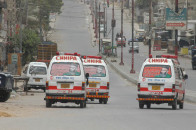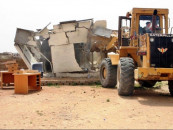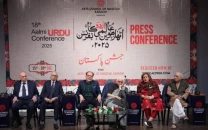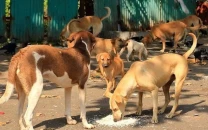Sewage-soaked beaches a health risk
Discharge of industrial toxic waste, oil from ships make a dip in surf a risky bet

The Clifton Beach and the Sea View were once the best places to visit for gusts of fresh air and sunshine and to enjoy the waves.
The beauty of the beach extending from the Old Clifton area to the later developed Sea View and the newer section of the Creek Vista has turned from bad to worse due to discharge of sewerage lines directly in the sea.
If such situation continues, the best picnic spot will become worst in the city. The beach front in the urban centre has been ruined due to marine pollution. It seems that authorities concerned are slumbering and have no time to pay heed towards this vital environment issue.
According to environment experts, Karachi generates 6.2 million tonnes of garbage annually, out of which 60 per cent is disposed of at garbage dumping sites while 40 per cent is abandoned at various places in the city.
Out of this 40 per cent, half is burnt and the other half is discharged into sea through Lyari and Malir rivers. Annually, 200 tonnes of plastic is abandoned in Malir River and 2,000 tonnes in Lyari River, which also flows into the sea, killing fish and other living things. About 465-472 millions of gallons per day (MGD) sewage is generated in the city while optimum design capacity of sewerage treatment plants is 150 MGD, shortfall in sewage treatment capacity is 322 MGD, quantity of sewage treated is 50 MGD and untreated sewerage is 417-425 MGD, according to a report.
International Union for Conservation of Nature (IUCN) says every year, thousands of tonnes of industrial waste is dumped into the sea. In the coastal areas of Karachi, this is a huge problem as Karachi happens to be the largest industrial hub of the country. Marine pollution has tremendous economic, health and biodiversity costs. Industrial waste, untreated sewage and oil spills contaminate the sea and pose a great threat to marine life. Oil is dangerous to marine life in several ways.
For instance, if furbearing mammals or birds get oil on their fur or feathers, they may not be able to fly or move properly, maintain body temperature, or feed. The oil washes up on beaches and contaminates nesting areas and feeding grounds of birds and sea turtles. Furthermore, pathogens entering the food chain through sewage will often be transmitted back to humans through seafood. Potentially fatal diseases such as typhoid and cholera are in fact highly prevalent in Pakistan.
Another effect of marine pollution is that a lot of the waste and litter dumped in the ocean eventually washes up on beaches, and hence ruins beach aesthetic and tourism. Polluted beaches pose a higher risk of catching diseases. According to official figures, 90 per cent of industrial effluent and sewage produced in the country’s biggest city is poured into the sea either directly or via Lyari and Malir rivers. About 2,500 ships and 200 oil tankers visit Karachi harbour through the Manora Channel annually.
There is large scale shipping traffic at Port Qasim. The sources of oil pollution in Manora channel are bilges, washings from engine rooms of vessels, discharges and leaks from bunkering point, and leaks and small spills occurring during loading and unloading at oil piers.
Oily waste from city based sources including service stations also ends up in the harbour area. Perhaps the greatest contributor to marine pollution along Pakistan’s coast is domestic sewage. About 550 million gallons per day (MGD) of mostly untreated wastewater is entering the coastal waters affecting the coastal areas; the problem would worsen if no remedial measures are undertaken. Karachi Water and Sewerage Board has established three sewage treatment plants.
Of the total 472 MGD, these plants treat only 55 MGD of sewage and the rest finds its way to the sea untreated. For the industrial waste of 78 MGD, there is only one treatment plant with a designed capacity of treating 10 MGD. The city district government of Karachi has planned to set up six treatment plants at several sites for sewage water treatment.
The marine pollution is killing fish and other sea life. It is also causing economic loss. The increased concentration of chemicals, such as nitrogen and phosphorus, in the coastal ocean promotes the growth of algal blooms, which can be toxic to wildlife and harmful to humans.
The negative effects on health and the environment caused by algal blooms hurt local fishing and tourism industries. The federal and Sindh governments need to establish effluent treatment plants besides taking steps to stop throwing of garbage into drains, Lyari and Malir Rivers so as to keep the sea clean and save its life, particularly fish. PPI



















COMMENTS
Comments are moderated and generally will be posted if they are on-topic and not abusive.
For more information, please see our Comments FAQ